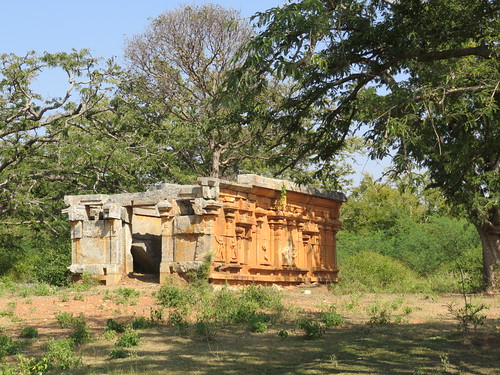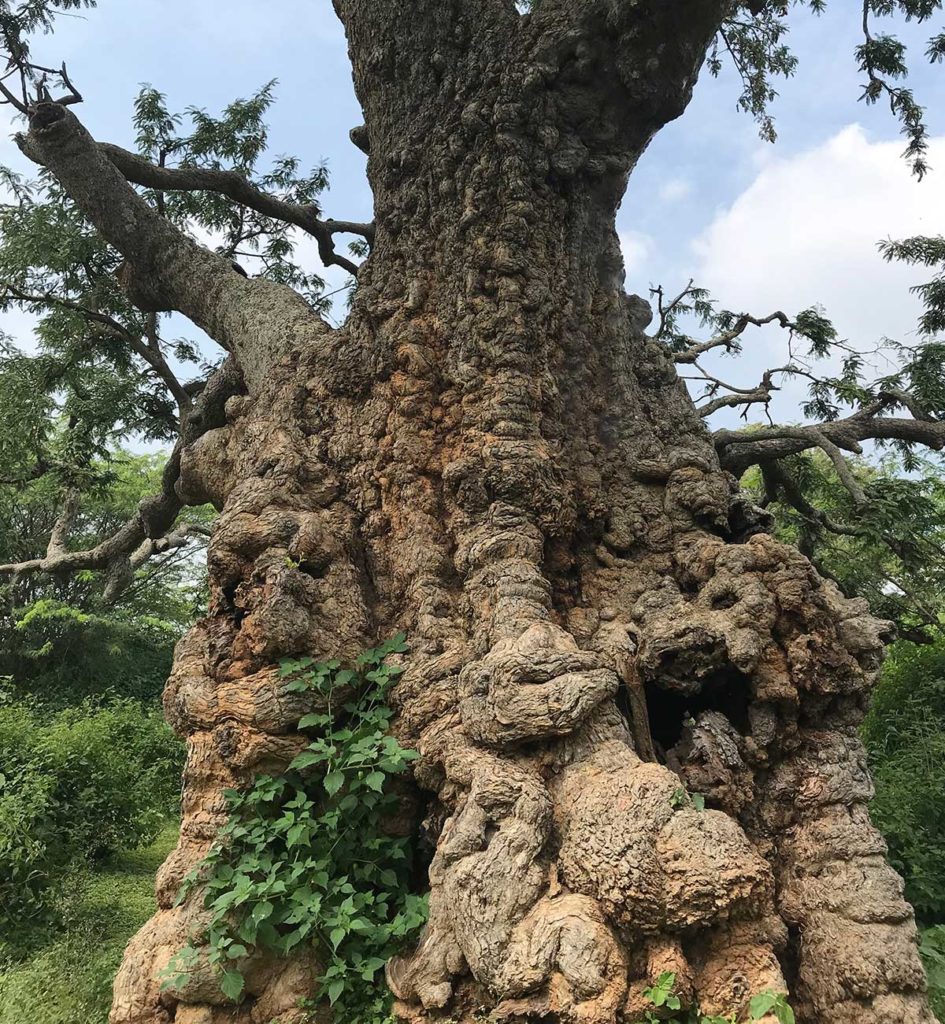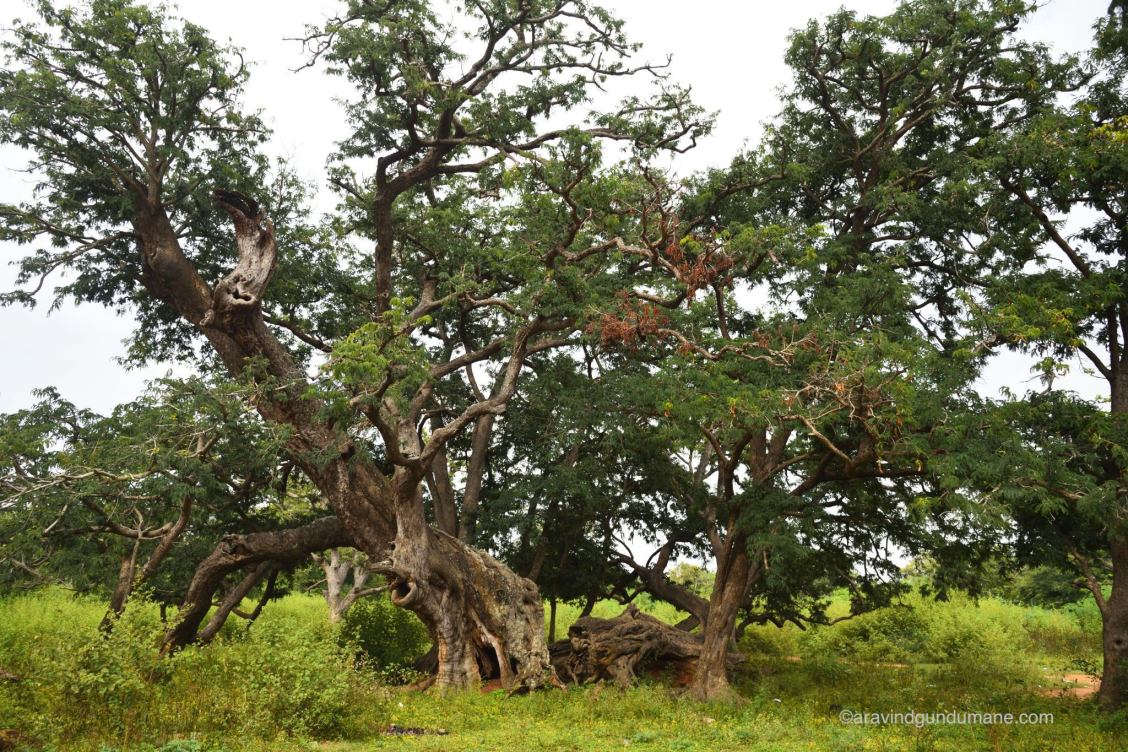Tucked away from the bustle of Bangalore city, lies 54 acres of land that is a site of ecological importance and cultural significance. Located just a few kilometers away from the Kempegowda International Airport, the Nallur Tamarind Grove can be sighted on the way from Devanahalli to Hoskote.
The site is home to 278 Tamarind trees of which the oldest is believed to be 410 years old. Several other trees within the ages of 50-200 years and upwards constitute a majority of the specimens in this stretch, which is extremely rare because the average lifespan of a tamarind tree is believed to be only around 200 years.

During a visit to the site Dr V Bhaskar, Professor of Forestry at the National Afforestation and Eco-Development Board, Ministry of Environment and Forests, observed several fascinating features of the trees in the grove. Some of them have developed adventitious roots composed of meristematic tissue growing downwards as prop roots. In some cases, these roots support the entire tree even if the mother trunk is dead. He explains that while this feature is common among Banyan trees, it is extremely uncharacteristic in the case of tamarind trees, adding to the enigma of the grove.
There are also instances where new trees have sprung up from these roots, baffling botanists and biotechnologists alike, leading to in-depth research on the longevity and productive years of old trees. He feels that this would also enable the grove to function as a gene bank to provide genetic material for further studies, reports Deepa Mohan in an article for Citizen Matters. All of this underlines the ecological significance of the location.
Owing to the dual importance of this space in terms of its ecological and cultural significance, the grove was declared as the country’s first Biodiversity Heritage Site in 2007. But this title contributed little towards extending the dignity or protection that it owed to the space, which presently shows drastic signs of deterioration as a result of neglect and irresponsible management
The origin of this grove can be dated back to the reign of the Chola dynasty in the 13th century when some of the tamarind trees are believed to have been planted. Spiking the interest of historians and archeologists, there are ruins of a temple dedicated to Lord Chennakeshava within the grove, which can be traced back to the 1300s. The engravings on the wall exhibit the architectural style of the Vijayanagar empire and a typical example of this would be the friezes depicting instances from the life of Lord Krishna. These structures within the ancient man-made grove hint at the presence of the 800-year-old Nallur fort which is believed to have been once located here.

Image: Citizen Matters Blog
Owing to the dual importance of this space in terms of its ecological and cultural significance, the grove was declared as the country’s first Biodiversity Heritage Site in 2007. But this title contributed little towards extending the dignity or protection that it owed to the space, which presently shows drastic signs of deterioration as a result of neglect and irresponsible management.
Also read: Kollakkayil Devaki Amma: The Woman Who Built A Forest
When the land was within the purview of the village panchayat until 2007, the trees were worshipped and the grounds taken care of by the villagers as observed by S V Hittalmani, retired Additional Director of the Department of Horticulture. He opines that the land began its journey into dilapidation post 2007, when sufficient facilities and funds were not allotted to ensure the continued protection of the space.
In an initiative by the Nallur Biodiversity Heritage Management Committee, the trees were numbered in 2008. But the lack of follow up is evident from the damaged state of the number plates and the half-hearted inspections by authorities that did little good as reported by Apoorva Puranik for The Economic Times.
Under the purview of the government, the lone guard appointed to watch over the vast expanse also proved to be insufficient as illegal encroachment and drinking parties left the grounds littered with broken bottles and garbage. The accumulation of waste is also due to the annual festivals at the newer temple within the grove which is a place of worship for around 12 nearby villages.
The trees also resonate with the lifestyle of the community as the tamarind fruit is a crucial ingredient for preparing several local delicacies. The religious context underlying the sacred nature of the grove is also well-known. Thus, the grove is interwoven with the fabric of the community and their culture, thereby highlighting the importance of incorporating it into conservation activities
Vijay Nishanth, Founder of Project Vruksha Foundation, is an urban conservationist who is part of the Bangalore Biodiversity Management Committee (BMC) which has been involved in the protection of this site. He feels that the involvement of the locals would be the way forward to instill a sense of belongingness among the local authorities and residents which would fill in as the necessary motivation factor needed for consistent maintenance of the land.
He believes that making the local community aware of the importance of such a place in their locality would position them as active members in the conservation process. Such an approach would function as a sustainable system of ecological protection, parallel to the governing bodies dedicated to it. Considering this as the most appropriate method when it comes to preserving living and breathing artefacts such as these tamarind trees, Nishanth exclaims how even the oldest among them still bear good quality fruit which generates revenue.
The trees also resonate with the lifestyle of the community as the tamarind fruit is a crucial ingredient for preparing several local delicacies. The religious context underlying the sacred nature of the grove is also well-known. Thus, the grove is interwoven with the fabric of the community and their culture, thereby highlighting the importance of incorporating it into conservation activities.
He hopes that his plans to organise volunteer-driven activities to regularly clean and monitor the land will spark further interest in the area as a tourist attraction and as a space of unique ecological importance. With reference to this goal, he speaks highly of the Bangalore authorities who took a keen interest in the case even though the grove is located outside their limits, which shows the dedication of the board members to protect this lesser-known gem.
His passion and attachment with the space translated into his words as he equates the age-old trees to rich treasure troves of history that stood witness to the story of a land. It would be an unimaginable tragedy to lose these trees and the site due to negligence or ignorance. This is why he insists on increased involvement on the part of the government to protect and maintain the grove which would then serve as an asset to future generations.

Kavya Chandra, the founder of sustainable living enterprise Green Venture also opined that tourism could be used to make citizens aware about the grove, thus pushing the need to protect it. This sentiment was also shared by Dr. Bhaskar who believes that people have to keep visiting the place and speaking about it to ensure its maintenance by the Karnataka Forest Department.
In accordance with the theme of the 2021 World Environment Day, the project of Ecosystem Restoration is one that the Nallur Tamarind Grove is in grave need of. The trees are nothing short of ecological marvels and time-honoured specimens. The historical and cultural significance of the space adds to the immediacy of the need to protect the ruins from complete dilapidation. In addition to the delicate and ancient roots and mother trunks, the number of bird species found in the ecosystem also saw a fall from 120 to 20.
The grove can be developed and restored into well-known site of tourism, environmental and historical interest. The ways in which we can contribute range from something as simple as visiting and sharing our experience of this place to getting involved with the activists and volunteers who are working to protect it. This would make every contribution count as they all add up to the larger goal of restoring and protecting the Nallur Tamarind Grove, a site of unparalleled intrigue and charm.
Also read: Remembering Chipko Movement: The Women-led Indigenous Struggle
Featured Image Source: Treks and Travels
About the author(s)
Akhila is a first year MA student pursuing English and Communication Studies at Christ University. She is hopeful about creating change through writing and academic praxis, and when that gets a little tiring, escapes into books and TV shows.




